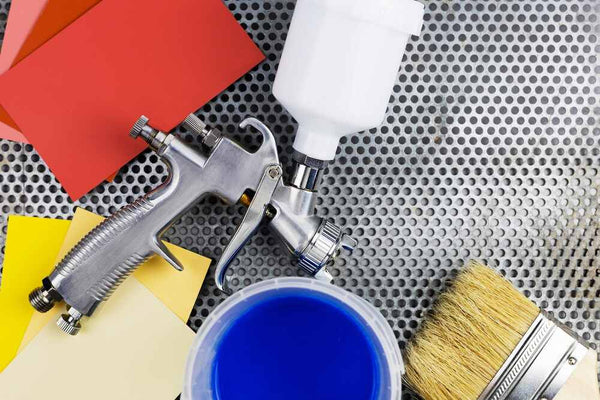Airbrushing is more than just another technique; it’s an important form of artistic expression!
With the right tools and a steady hand, you can effortlessly blend colors, create stunning gradients, and achieve intricate details. You can turn any canvas or wall into a masterpiece.
Join us as we explore the world of airbrushing with acrylic paints. We’ll go over airbrush tips for beginners that can empower you to take your artistry to the next level.
Getting Started with Airbrushing
First things first, what is airbrushing anyway? An airbrush compressor is a handy piece of equipment that uses air pressure and spray tips to create fine sprays of paint that provide effortless coverage and seamless blending.
As Art in Context explains, the primary concept on which an airbrush functions is pretty simple: Compressed air passes through a venturi which is basically a tapered hole. This happens at quite a high speed to create a seamless spray.
It’s a similar concept to spray paint, except the paint is even more compressed and the spray tips are more refined. Airbrush tips and tricks can help you control the spray pattern, intensity, and radius of your paint to perfection.
An airbrush painting can look seamless and almost appear like a photograph. You can also use it to create splatter techniques and more abstract piece pieces of art.
Choosing the Right Equipment
Before diving into airbrush beginner tips, it’s important to make sure you’re set up with the right equipment. Here are some of the tools you should have on hand:
- Airbrush: There are many types of airbrushes for artists to choose from. For the casual artist looking for complete coverage, Everything Airbrush recommends a simple single-action airbrush.
- Mask or respirator: Since airbrushes release a fine mist of spray, it’s important to wear a mask or respirator when using one to protect your lungs. On that note, you should always use an airbrush in a well-ventilated room.
- Acrylic paint: Of course, you also need acrylic paint. For this technique, it’s best to use more fluid paint, so you should consider having an acrylic retarder or other thinning medium.
Paint Purchased after Viewing this Post
These are the basics. You may also want to prepare your space by putting a tarp down and removing anything you wouldn’t want to get paint spray on as a precaution.

Essential Tips for Airbrushing
Now, for what you’ve been waiting for. Here are some essential airbrush tips for beginners to help you get started mastering this technique.
1. Know Your Airbrush
Every airbrush is different. As a beginner, you’re likely faced with two options: dual-action or single-action airbrushes. They operate slightly differently.
The former allows you to control both air and paint flow at the same time. A single action has independent controls for air and paint. Which you choose depends on your comfort level and preferences. The dual action provides more precision, while a single action may be easier for beginners to use.
2. Paint Consistency is Key
One of the best airbrush tips to follow is to ensure your paint consistency is correct. If your paint is too thick it won’t spray evenly. If it’s too thin, on the other hand, it won’t create an even coating on the canvas or other surface.
Make sure to use more fluid paint, like acrylic. Then, use a medium to help create a looser consistency if desired.
3. Holding Your Airbrush
Point Zero recommends holding an airbrush similar to how you’d hold a pen, with the index finger on the trigger. Some use two hands for added support.
It’s best to use your thumb as support, and not on the trigger. When it comes to using your airbrush, make sure to hold it the correct distance away from your canvas. Holding it at different distances will create unique results, such as a more opaque spray if far away and closer splatters if held close.
4. Use Stencils
Stencils will help you achieve precision with your airbrush. Even experienced airbrush artists use stencils to effortlessly fill spaces with a fine spray! Then use sponges or brushes to create gradients.
5. Clean Your Airbrush
Finally, don’t forget to clean your airbrush between colors and after use. Investing in a cleaning brush can help you completely clean the bottle joint and ensure there isn’t any residue left behind. Proper cleaning ensures colors don’t blend unintentionally and that residue doesn’t build up in the spray nozzle.
Ready to try some of these tips and tricks for yourself? Browse our selection of artist-quality acrylic paint to prepare for your next project.




























































